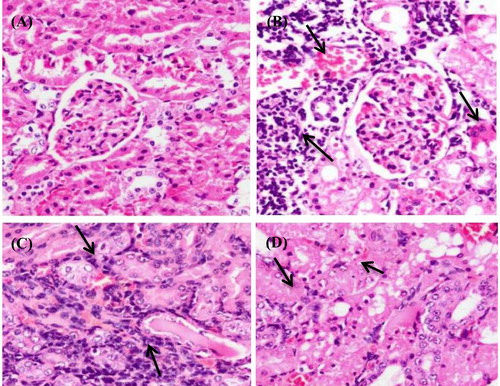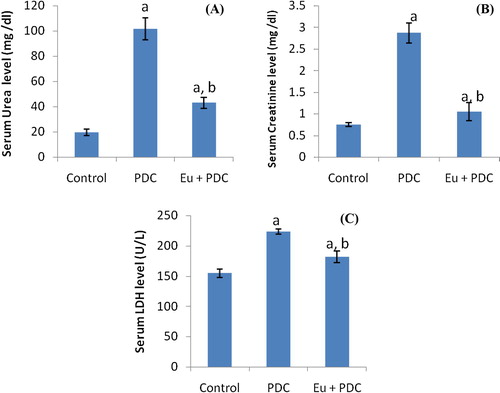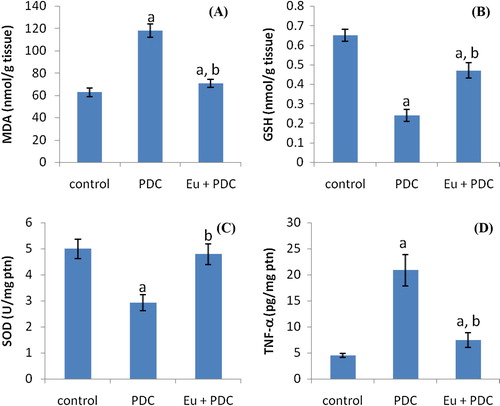Abstract
Background
Potassium dichromate induces nephrotoxicity mainly due to increased cellular oxidative stress.
Objectives
To evaluate the possible renoprotective effects of eugenol on the damage induced by potassium dichromate poisoning in male rats.
Methods
30 male Wistar rats were divided into 3 groups, 10 rats in each group; Control group: given olive oil orally (5 mL/kg body weight) for 10 consecutive days. Potassium dichromate (PDC) group: received olive oil orally (5 mL/kg body weight) for 10 consecutive days, then a single s.c. injection of PDC (15 mg/kg) was given in the tenth day. And eugenol + PDC group: received eugenol orally (100 mg/kg body weight/day) for 10 consecutive days and a single s.c. injection of PDC (15 mg/kg) in the tenth day.
Then the animals were anaesthetized, blood samples were taken from the abdominal aorta, for measurement of serum urea and creatinine, and lactate dehydrogenase (LDH). Also reduced glutathione (GSH), malondialdehyde (MDA), superoxide dismutase (SOD) and tumor necrosis factor alpha (TNF-α) were monitored in renal tissue.
Results
PDC caused significant increase in serum urea, creatinine and LDH levels; this was accompanied with significant decrease in renal GSH and SOD contents, and increase in renal MDA and TNF-α. Histopathological investigations provoked tubular necrosis associated with mononuclear cell infiltration. Pretreatment of rats with eugenol significantly change all previously mentioned PDC-induced effects.
Conclusion
The findings of the current study revealed that eugenol protected the kidney against PDC-induced acute kidney injury in rats by its antioxidant and anti-inflammatory properties.
1 Introduction
Chromium (Cr) is a heavy metal that has several valence states; the most common one is the hexavalent chromium (CrVI), that is widely used in industries, e.g. leather tanning, stainless steel manufacturing, chrome plating (chromates added as anticorrosive agents to paints, primers, and other surface coatings), welding and wood preservation.Citation1,Citation2 CrVI can also be found in drinking water and in public water systems.Citation3 Environmental and/or occupational exposure to CrVI-containing compounds is known to be toxic and carcinogenic to human beings and animals.Citation4 A major adverse effect of chromium poisoning is nephrotoxicity due to chromium excretion through the kidney, this increases its chromium content and subsequently, nephropathy occurs.Citation5 The toxic manifestations of chromium are considered to be due to oxidative stress.Citation6,Citation7 leading to serious damage to the vital organs.Citation8,Citation9
Potassium dichromate is used to induce oxidative kidney damage.Citation10 Nephrotoxicity induced by PDC in rat mimics the occupational hazard.Citation11
Eugenol (1-allyl-4-hydroxy-3-methoxybenzene, C10H12O2) is a naturally occurring substance, extracted from certain essential oils especially clove oil as well as nutmeg, cinnamon, and basil oils.Citation12,Citation13 It has many pharmacological properties such as antioxidant, analgesic, anti-inflammatory, and antipyretic actions,Citation12,Citation14 while it has been shown to ameliorate kidney injury in streptozotocin-induced diabetic rats,Citation15 and in gentamycin induced nephrotoxicity,Citation16 but its effect on PDC induced nephrotoxicity has not been investigated yet. So, this study aimed to assess the possible protective effect of eugenol, in a PDC induced acute kidney injury rat model.
2 Material and methods
2.1 Animals
This study was conducted on 30 male Wistar rats, weighing 200–220 g. purchased from the Experimental Animal House of Faculty of Science, Tanta University. The rats were kept in plastic cages (5 rats per cage) under controlled environmental conditions, 12/12 h light/dark cycle, at room temperature (23 ± 2 °C), with free access to water and food. All protocols were approved by the Tanta University ethical committee, (code approval number: 40118/08/29).
2.2 Chemicals
In this study, eugenol and PDC were purchased from Sigma- Aldrich (USA). They were diluted and dissolved in olive oil and saline (0.9%) respectively for administration.
2.3 Study design
Rats were divided into 3 groups, 10 rats per each group.
Control group: Rats were gavaged with olive oil (5 mL/kg body weight/day) for 10 consecutive days.
PDC group: Rats were daily gavaged with olive oil, like control group, then intoxicated in the tenth day with a single s.c. injection of PDC (15 mg/kg) freshly dissolved in saline.Citation17
Eugenol (Eu) + PDC group: Rats received eugenol orally (100 mg/kg body weight/day) for 10 consecutive days,Citation16 and a single s.c. injection of PDC (15 mg/kg) in the tenth day.Citation17
The doses of eugenol and PDC employed were the effective doses that used in previous researches.
Twenty-four hours after the last treatment, rats in all groups were anaesthetized with ketamine (75 mg/kg). Midline laparotomy was performed. Blood samples were taken from the abdominal aorta, then serum was separated by centrifugation (3000 rpm for 10 min) for the immediate analysis of urea and creatinine, and aliquot was then stored until further analysis.
Also the kidneys were immediately dissected out for histopathological evaluation, and biochemical analysis of renal tissue. Finally, the rats were sacrificed by decapitation under general anesthesia.
2.4 Estimation of renal function biomarkers
Serum urea and creatinine were determined colorimetric, according to Bauer et al.Citation18 method.
2.5 Estimation of renal tissue damage marker in serum
Serum lactate dehydrogenase (LDH) was estimated colorimetric, according to Sharma, and DattaCitation19 method.
2.6 Estimation of oxidative stress markers in kidney
Weighed parts from both kidneys were homogenized in ice-cold 0.1 M sodium phosphate buffer (pH 7.4) to prepare a 10% (w/v) tissue homogenate. The homogenate was centrifuged for 30 min at 4000 rpm at 4 °C. The resultant supernatant was used to measure reduced glutathione (GSH), malondialdehyde (MDA) and superoxide dismutase (SOD), using GSH, MDA and SOD assay kits, according to the methods described by Akerboom and Sies,Citation20 Janero,Citation21 and Kuthan et al.Citation22 respectively.
2.7 Estimation of inflammatory biomarker in kidney
Tumor necrosis factor alpha (TNF-α) was determined in the kidney using TNF-α ELISA kit (obtained from Sigma chemical Co.), according to Navarro et al.Citation23 method.
2.8 Histopathological analysis
Parts of kidneys from all groups were fixed in 10% buffered formalin for 72 h. at room temperature then washed under running water, dehydrated in ascending concentrations of ethanol, cleared in xylene and finally, embedded in paraffin. Then sections of 5 μm thickness were stained with hematoxylin and eosin and evaluated by light microscopy.Citation24
2.9 Statistical calculations
Collected data were statistically analyzed by one–way ANOVA, followed by Tukey test, to determine statistical significance between different groups using SPSS software package 23.0. Data was presented as mean ± SD, and P < 0.05 was considered statistically significant.
3 Results
3.1 Effect of eugenol on kidney function and serum LDH
A significant elevation in serum urea, creatinine and LDH levels was observed in PDC group compared with those of control group. Pretreatment with eugenol, significantly decreased their levels when compared with PDC group, but still significantly elevated when compared with those of control group ().
3.2 Effect of eugenol on kidney oxidative stress markers
Renal GSH and SOD levels were significantly reduced, while a significant elevation of renal MDA content was detected following PDC administration. Treatment of rats with eugenol, prior to PDC injection significantly elevated GSH and SOD levels, with normalization of SOD level, while GSH level still significantly lower than normal control values. Also, MDA level was significantly reduced after pretreatment with eugenol, and still significantly higher than normal control values ().
3.3 Effect of eugenol on renal inflammatory biomarker
PDC injection significantly increased renal TNF-α level, compared to the control group. The rats treated with eugenol showed a significant decrease in renal TNF-α level compared to the PDC group, but its level still significantly higher compared to the control group ().
3.4 Histopathological observations
The kidney sections from the rats of control groups showed normal histological structures with normal glomeruli and renal tubules (a), PDC caused histopathological alterations in the form of diffuse coagulative necrosis in most of the renal tubules, congestion of interstitial blood vessel, associated with fibroblastic proliferation and mononuclear cell infiltration (b, c). These alterations were markedly reduced in Eu + PDC group as renal tubules showed mild tubular damage and very mild inflammatory cell infiltrates in addition to few regenerative renal tubules (d).
Fig. 3 Kidney histopathology (X400). (A) Control group: normal histological structure of the glomeruli and tubules. (B) PDC group: congestion of interstitial blood vessel, diffuse coagulative necrosis in most of the renal tubules and mononuclear cell infiltration. (C) PDC group: fibroblastic proliferation and mononuclear cell infiltration (D) Eu + PDC group: focal necrosis of epithelial lining associated with uniformly arranged regenerative renal tubules.

4 Discussion
Potassium dichromate was used to induce oxidative kidney damage.Citation10 The kidneys were considered to be the target organs of systemically absorbed chromate, and nephrotoxicity could be the primary cause of death in cases of acute chrome exposure.Citation5 The massive reactive oxygen species production was considered to be the cause of toxic effect of PDC, and has been attributed to the reduction of hexavalent chromium to trivalent one, which induces damage of cellular components.Citation25 The tubular damage and nephrotoxic effect of chromate resulted from its accumulation in vacuoles inside the cells of proximal convoluted tubules that lead to slow excretion and remaining of Cr in the kidney for a long time.Citation26
In the present study, injection of a single dose of PDC, induced acute kidney injury in rats as evidenced by the significant alteration of the serum levels of urea, creatinine and LDH and confirmed with the severe changes in histopathology of PDC group, particularly tubular necrosis. These results are denoting the nephrotoxic effect of PDC, and are in accordance with those reported by Salama et al.,Citation10 Arreola-Mendoza et al.,Citation27 and Yam-Canul et al.Citation28
This nephrotoxic effect of PDC could be attributed to the PDC induced oxidative stress, as evidenced by increased level of MDA and decreased levels GSH and SOD in the kidney tissues of PDC group. Another mechanism of nephrotoxic effect of PDC may be increased inflammatory process as evidenced by significant increase of the renal TNF-α level after PDC injection, and confirmed by histopathological findings especially, mononuclear cell infiltration, but this increased inflammatory process may be promoted by oxidative injury of the renal tissues itself.Citation29 These findings are in accordance with many other studies.Citation10,Citation27 Also, Beaver et al.Citation30 reported induction of acute inflammatory reaction with neutrophils, macrophages, and lymphocytic cell infiltration induced by chromium.
In this study, pretreatment of rat with eugenol markedly protected the kidney against PDC-induced AKI and oxidative stress, as evidenced by the significant decrease in serum levels of urea, creatinine and LDH and improvement of histopathological changes occurred in PDC group as well as significant changes in renal contents of MDA, GSH and SOD. The anti-inflammatory effect of eugenol was confirmed by the significant decrease of TNF-α and by the histopathological findings that showed marked improvements of renal tissues with mild degenerative changes in the epithelial lining of renal tubules with no evidence of interstitial inflammatory cell infiltrate in rats treated by eugenol.
The antioxidative potential of eugenol has been studied in a number of studies where it has been shown to bind to free oxygen radicals and attenuate the action of oxidative substances.Citation16,Citation31–Citation33
Also, the anti-inflammatory effects of Eugenol has been described by Huss et al.,Citation34 it was also reported that eugenol acts as an anti-inflammatory substanceCitation35 and reducing the release of proinflammatory mediators such as TNF-α, and PGE2.Citation36,Citation37
5 Conclusion
The present study confirmed that eugenol offers protection against PDC-induced AKI in rats by its direct antioxidant effect and by lowering the production of inflammatory mediators such as TNF-α.
Conflict of interest
We have no conflict of interest to declare.
Acknowledgments
The author would like to thank Dr. Eman El Saed, the assistant professor of pathology for her help in the histopathological part of this study.
Notes
Peer review under responsibility of Alexandria University Faculty of Medicine.
Available online 19 June 2018
References
- M.KeaneA.SiertS.StoneB.T.ChenProfiling stainless steel welding processes to reduce fume emissions, hexavalent chromium emissions and operating costs in the workplaceJ Occup Environ Hyg131201618
- B.PeschB.KendziaK.HauptmannAirborne exposure to inhalable hexavalent chromium in welders and other occupations: estimates from the German MEGA databaseInt J Hyg Environ Health2182015500506
- Y.XieS.HolmgrenD.M.K.AndrewsM.S.WolfeEvaluating the impact of the U.S. national toxicology program: a case study on hexavalent chromiumEnviron Health Perspect12522017181188
- F.MigniniD.TomassoniE.TrainiImmunological pattern alteration in shoe, hide, and leather industry workers exposed to hexavalent chromiumEnviron Toxicol242009594602
- R.HegazyA.SalamaD.MansourA.HassanRenoprotective effect of lactoferrin against chromium-induced acute kidney injury in rats: involvement of IL-18 and IGF-1 inhibitionPLoS ONE1132016e0151486
- K.JomovaM.ValkoAdvances in metal-induced oxidative stress and human diseaseToxicology28320116587
- S.J.StohsD.BagchiOxidative mechanisms in the toxicity of metal ionsFree Radic Biol Med181995321336
- M.M.AruldhasS.SubramanianP.SekarChronic chromium exposure-induced changes in testicular histoarchitecture are associated with oxidative stress: study in a non-human primate (Macaca radiata Geoffroy)Hum Reprod20200528012813
- S.I.NudlerF.A.QuinterosE.A.MilerJ.P.CabillaS.A.RonchettiB.H.DuvilanskiChromium VI administration induces oxidative stress in hypothalamus and anterior pituitary gland from male ratsToxicol Lett1852009187192
- A.SalamaB.ElsayehI.IsmaielS.El-ShenawyComparative evaluation of protective effects of green tea and lycopene in potassium dichromate-induced acute renal failure in ratsJ Chem Pharm Res6122014168177
- L.N.ZengZ.J.MaY.L.ZhaoThe protective and toxic effects of rhubarb tannins and anthraquinones in treating hexavalent chromium-injured rats: the Yin/Yang actions of rhubarbJ Hazard Mater246–247201319
- K.PramodS.H.AnsariJ.AliEugenol: a natural compound with versatile pharmacological actionsNat Product Commun512201019992006
- A.B.TikuS.K.AbrahamR.K.KaleEugenol as an in vivo radioprotective agentJ Radiat Res452004435440
- X.ZhaoD.ChenP.GaoP.DingK.LiSynthesis of ibuprofen eugenol ester and its microemulsion formulation for parenteral deliveryChem Pharm Bull53200512461250
- M.S.GarudY.A.KulkarniEugenol ameliorates renal damage in streptozotocin-induced diabetic ratsFlavour Fragr J3220175462
- M.M.SaidThe protective effect of eugenol against gentamicin-induced nephrotoxicity and oxidative damage in rat kidneyFund Clin Pharmacol2562011708716
- M.R.KhanS.SiddiquiK.ParveenS.JavedS.DiwakarW.A.SiddiquiNephroprotective action of tocotrienol-rich fraction (TRF) from palm oil against potassium dichromate (K2 Cr2 O7)-induced acute renal injury in ratsChem Biol Interact18622010228238
- J.H.BauerC.S.BrooksR.N.BurchRenal function studies in man with advanced renal insufficiencyAm J Kidney Dis1119823035
- A.K.SharmaP.DattaSpectrophotometric estimation of serum lactate dehydrogenase with semicarbazide in the reaction mediumClin Chim Acta3211971134136
- T.P.AkerboomH.SiesAssay of glutathione, glutathione disulfide, and glutathione mixed disulfides in biological samplesMethods Enzymol771981373382
- D.R.JaneroMalondialdehyde and thiobarbituric acid-reactivity as diagnostic indices of lipid peroxidation and peroxidative tissue injuryFree Rad Biol Med91990515540
- H.KuthanH.J.HaussmannJ.WerringloerA spectrophotometric assay for superoxide dismutase activities in crude tissue fractionsBiochem J23711986175180
- J.F.NavarroC.Mora-FernandezThe role of TNF-alpha in diabetic nephropathy: pathogenic and therapeutic implicationsCytokine Growth Factor Rev172006441450
- R.DruryE.WallingtonCarleton's histology technique4th ed.1967Oxford University PressNew York, Toronto432
- A.FloresJ.M.PerezCytotoxicity, apoptosis, and in vitro DNA damage induced by potassium chromateToxicol Appl Pharmacol16119997581
- J.Pedraza-ChaverríD.BarreraO.N.Medina-CamposTime course study of oxidative and nitrosative stress and antioxidant enzymes in K2Cr2O7-induced nephrotoxicityBMC Nephrol620054
- L.Arreola-MendozaJ.L.ReyesE.MelendezAlphatocopherol protects against the renal damage caused by potassium dichromateToxicology2182006237246
- P.Yam-CanulY.I.ChirinoD.J.Sanchez-GonzalezNordihydroguaiaretic acid attenuates potassium dichromate-induced oxidative stress and nephrotoxicityFood Chem Toxicol46200810891096
- E.HomsiD.D.AndreazziJ.B.FariaP.JaninoTNF-α-mediated cardiorenal injury after rhabdomyolysis in ratsAm J Physiol Renal Physiol30811201512591267
- L.M.BeaverE.J.StemmyS.L.ConstantLung injury, inflammation and Akt signaling following inhalation of particulate hexavalent chromiumToxicol Appl Pharmacol23520094756
- C.MarkakisA.TsarouchaA.E.PapaloisThe role of eugenol in the prevention of acute pancreatitis-induced acute kidney injury: experimental studyHPB Surg201620163203147
- D.N.CriddleS.V.Frota MadeiraR.S.De MouraEndothelium-dependent and -independent vasodilator effects of eugenol in the rat mesenteric vascular bedJ Pharm Pharmacol5532003359365
- N.VidhyaS.N.DevarajAntioxidant effect of eugenol in rat intestineInd J Exp Biol3712199911921195
- U.HussT.RingbomP.PereraL.BohlinM.VasängeScreening of ubiquitous plant constituents for COX-2 inhibition with a scintillation proximity based assayJ Nat Prod65200215171521
- Y.Y.LeeS.L.HungS.F.PaiY.H.LeeS.F.YangEugenol suppressed the expression of lipopolysaccharide induced proinflammatory mediators in human macrophagesJ Endodontics3362007698702
- J.N.SharmaK.C.SrivastavaE.K.GanSuppressive effects of eugenol and ginger oil on arthritic ratsPharmacology4951994314318
- S.FujisawaT.AtsumiY.KadomaH.SakagamiAntioxidant and prooxidant action of eugenol-related compounds and their cytotoxicityToxicology177120023954


